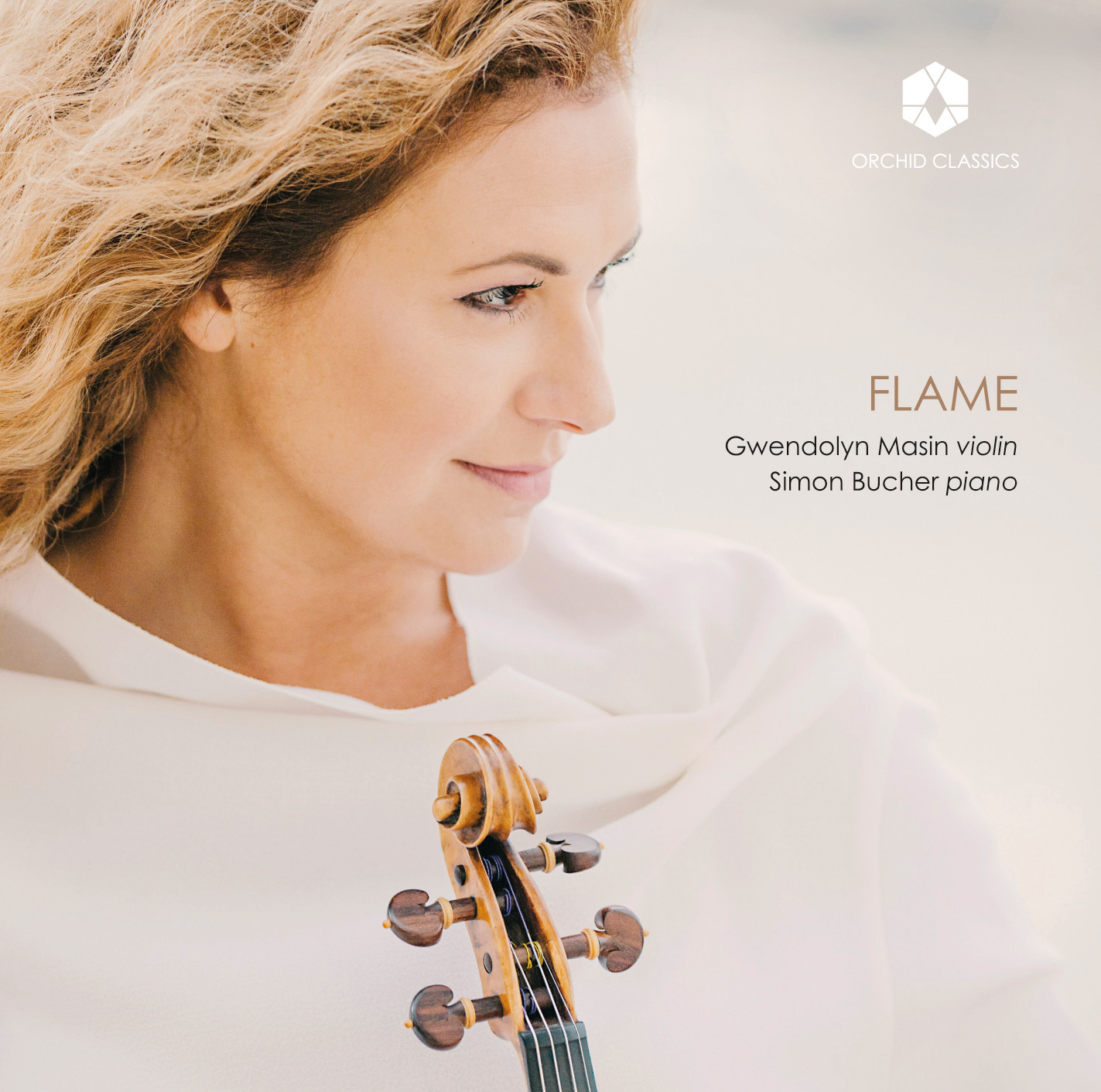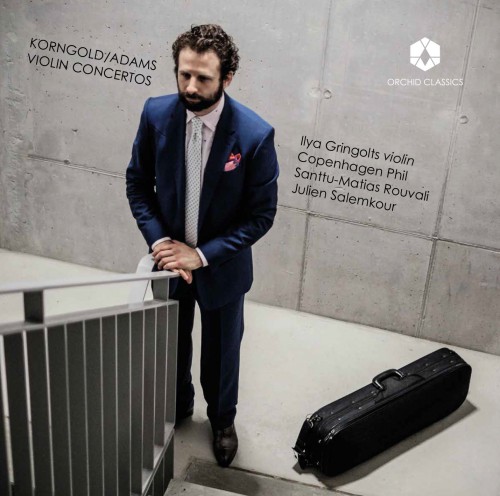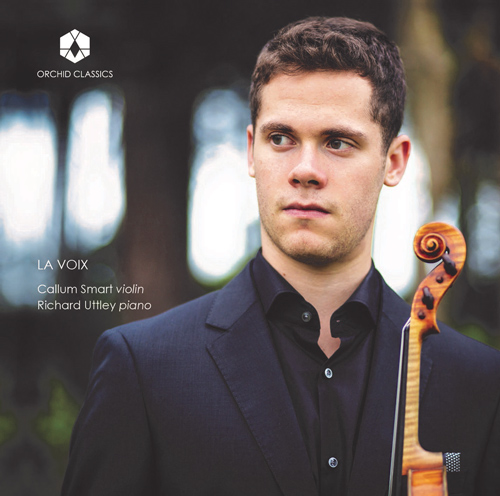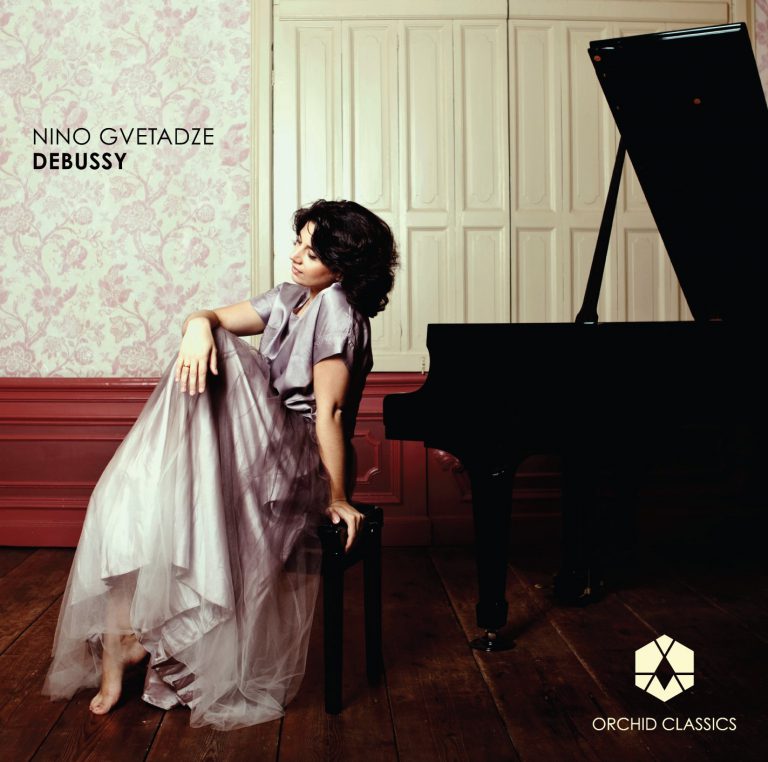Artist Led, Creatively Driven

FLAME
Gwendolyn Masin, violin
Simon Bucher, piano
Release Date: 17 November 2017
ORC100075
FLAME
Claude Debussy (1862-1918)
Violin Sonata in G minor, L140
I Allegro vivo 4.32
II Intermède – Fantasque et leger 4.14
III Finale – Très animé 4.25
Karol Szymanowski (1882-1937) (arr. Paul Kochanski)
Chant de Roxane from the opera “King Roger” 4.37
Gabriel Fauré (1845-1924) (arr. Wolfgang Birtel)
Après un rêve, Op.7 No.1 for violin and piano 2.51
Olivier Messiaen (1908-1992)
Thème et Variations for violin and piano
Thème: Modéré – 1ère Variation: Modéré – 2ème Variation:
Un peu moins modéré – 3ème Variation: Modéré, avec éclat –
4ème Variation: Vif et passionné – 5ème Variation: Très modéré 7.48
Igor Stravinsky (1882-1971) (arr. Samuel Dushkin)
Berceuse for violin and piano from “The Firebird” 3.13
Claude Debussy (1862-1918) (arr. Jascha Heifetz)
Beau soir for violin and piano 2.21
Maurice Ravel (1875-1937)
Violin Sonata No.2 in G major for violin and piano
I Allegretto 7.35
II Blues, Moderato 5.11
III Perpetuum mobile, Allegro 3.43
Total time 51.27
Gwendolyn Masin violin
Simon Bucher piano
About this album
During the recording of this album, I was in a period of my life where I found myself musing about fate, choice and the intersection between the two. My mind and heart became absorbed by the transience of things. Is it choice or fate that shepherds me, and the world at large? While music and performing are dear to me, so are the people and places with whom I interact. Once written, a musical composition is fixed on the page. But, when it’s given over to a musician or the listener, it comes alive and can evolve and change just as perspectives, people and places do. In this way, the abstract and the literal, the physical and the metaphysical, reality and the imagined world of daydreams and potentiality, work together.
As I made this album and worked with these pieces, I reflected that one of the most beautiful and simultaneously abstract and absolute of things to survive all of us is music. My personal musing added to this and ignited a flame within. Music can withstand time the way people and places cannot, but in ways that memories and the spirit can. To me, music is the connecting thread through time and space, past and present, my inner and outer world. The magnanimous impermanence of each moment, just like the melodies, rhythms and emotion of music, becomes all the more tangible.
The poem, Après un rêve, echoes the musings I had during the time of this album’s creation. I cannot think of the lyrics without being deeply touched by the notion that choice, perhaps, bears no weight on fate and the tension which is bound to this duality. What conclusion can we come to after hearing a work such as this or one such as Messiaen’s Thème et Variations? Carried through it is an almost ceaseless series of ascensions and descents of the musical line. It is, for me, caught between Earth and the ethereal. It is a flight of energy, and it resigns itself at its end – but to what?
The final movement of Debussy’s Sonata for Violin and Piano often leaves me aware of the ceaseless energy we leave behind long after death. Whether I play these pieces, Stravinsky’s Berceuse, from his Firebird Suite, or meditate on the poem to Debussy’s Beau Soir, I am left with more questions, my perspective shifts, and I am filled with wonderment and curiosity.
These works are connected, for me, through their fluidity of composition. Some bear symbolic meaning, of course. Nonetheless, they move like water, and they move through time and space. The signatures of the composers and the beauty woven through this music put me in conversation with grace. Whether it be wistfulness, melancholy, nostalgia, longing – each piece tells a story, and each time I play these pieces it feels as though I am telling this story for the first time. They are compositions that open up the world to me in unique ways. The passion I feel for these oeuvres, and the vitality that they offer, is something I have kept with me and carried for years. They possess movement that I know to be the same movement of the human spirit – they enact, they enthrall, they enliven – and in all this movement, there is transcendence.
Gwendolyn Masin
Inevitably, both World War One and his own diagnosis with cancer had a profound impact on Debussy’s state of mind. His former élan gave way to introspection, a shift reflected musically in three significant chamber works: the Cello Sonata and the Sonata for flute, viola and harp, both dating from 1915, and the Violin Sonata, which was finished with great effort in the spring of 1917. It was Debussy’s last complete work; a year later, on 25 March 1918, he died.
Debussy, taking the piano part, performed the Violin Sonata with Gaston Poulet on 5 May at the Salle Gaveau – his last Paris concert – and again in September at St-Jean-de-Luz; his final public performance.
Perhaps surprisingly for such a late work, the Violin Sonata opens with a movement cast loosely in sonata form – an unusually conventional choice for Debussy. Yet the two main themes are treated with the languid flexibility one associates with Debussy, characterised by his use of the pentatonic scale and decorative flourishes. Pierrot, the lovesick clown who made an appearance in the Cello Sonata, may be detected again in the central movement, this time in a more playful mood. The finale refers to the opening movement, its rondo theme described by Debussy to his friend Robert Godet:
“Through a quite humane contradiction, it is full of a joyous tumult. In the future mistrust those works which appear to soar across the sky; often they have wallowed in the dark of a gloomy brain. Such is the finale of this sonata, which goes through the most curious deformations ending up with the simple game of an idea which turns on itself like a snake swallowing its tail.”
Szymanowski’s Chant de Roxane was arranged for violin and piano by Paul Kochanski. The song comes from Act II of Szymanowski’s opera, Król Roger (King Roger), which was finished in 1924 and premiered in Warsaw two years later. The king’s wife, Roxana, sings a seductive melody in response to the arrival of a Shepherd, prompting a jealous response from her husband.
Fauré’s Trois mélodies for voice and piano were composed separately between 1870 and 1877 before being published as a set, Op.7, in 1878. The first, Après un rêve, describes a vivid dream in which the poet revels in the fantasy of escaping with his loved one, only to wake to reality, longing to return to the dream.
Messiaen’s Thème et variations was his first piece of instrumental chamber music, composed in 1932 for his first wife, violinist-composer Claire Delbos, as a wedding present. Messiaen’s pet name for Delbos was “Mi” – an E in the sol-fa scale, so he dedicated the work to her by writing this note at the beginning of the score. Messiaen wrote the piece in their new home on the outskirts of Paris, and the pair gave its premiere on 22 November 1932, at a concert given by the Cercle Musical de Paris. Messiaen encouraged his friend Jean Langlais to attend and “make lots of enthusiastic noise and try to get the piece encored, as it is one of my best.”
After the concert, Le Ménestrel provided a remarkably prescient summary of Messiaen’s style, as “aspiring continuously to a spiritual world – there is great nobility here, but writing this kind of music is not without risks.” The opening theme, supported by Messiaen’s characteristically colourful chords, is varied at increasing speed, before the final restatement, played an octave higher. It was this work which prompted Pierre Boulez to seek out Messiaen as his teacher:
“… an almost chance hearing of one of his earliest [works] – Thème et variations – was enough to inspire me with an immediate wish to study with him. I felt the force of his attraction immediately, as I say, at a single hearing.”
At the end of 1930, Stravinsky was introduced by his German publisher, Willy Strecker, to the Polish-American violinist Samuel Dushkin. Though not the greatest violin virtuoso of the age, Dushkin was a well-informed musician who helped Stravinsky with idiomatic violin writing; the two worked well together. They embarked on a series of projects, including the idea of putting together a recital programme with a view to increasing their performance engagements. An embryonic version was given in Milan in March 1932, after which the pair struck on the idea of what Stravinsky, writing to Strecker, called “un joli Kammerabend” – a charming chamber evening, consisting of violin and piano pieces and transcriptions composed or arranged by Stravinsky. Their recital programme now finalised, the two embarked on concert tours of the UK, France and the USA.
Amongst these transcriptions was the Berceuse from Stravinsky’s ballet, L’Oiseau de feu (1910), a piece which had been used by the composer in his 1919 ballet suite, and which would also make its way into the 1945 suite. Stravinsky later explained, in conversation with Robert Craft:
“I have already criticized Firebird twice, in my revised versions of 1919 and 1945, and these purely musical criticisms are stronger than words.
Am I too critical? Does Firebird contain more real musical invention than I am able or willing to see? I wish this were the case… If an interesting construction exists in Firebird, it will be found in the treatment of intervals, in the major and minor thirds in the Berceuse, in the Introduction, and in the Kastchei music.”
Debussy composed his song Beau soir, to a poem by Paul Bourget, when he was still a teenager, aged about 15 or 16, in 1877 or 1878 (at around the time Fauré’s Après un rêve was published). His fellow composition students at the Paris Conservatoire picked up on his literary tastes: Paul Vidal recalled that Debussy was “very fond of the poetry of Paul Bourget” and, similarly, Raymond Bonheur described Debussy arriving for classes “at the last minute, coming across the courtyard of the old Conservatoire with the short, hurried steps which always characterised him… Most of his settings of Bourget date from those long distant days…” The celebrated violinist Jascha Heifetz arranged this song for violin and piano.
Ravel began writing this Sonata No.2 in 1923 for perhaps his closest female friend, violinist Hélène Jourdan-Morhange. Ravel had already contemplated writing a concerto for her, and he dedicated this work to the violinist. Yet Jourdan-Morhange would never perform Ravel’s Sonata: it was at around this time that her career was cut short by rheumatism or motor cramps. This may have contributed to the length of time taken by Ravel to complete the work: in January 1924 he wrote to Manuel de Falla: “I thought I would finish my Violin Sonata towards the beginning of February. I have just abandoned it…”
Ravel sought not to unify the timbres of violin and piano, but rather to emphasise their differences, even their incompatibilities, in this work. The first movement stresses the piano’s brittle qualities as opposed to the violin’s lyricism. The piano’s parallel chords, spiky interjections and running figurations, and the ethereal violin lines, are distinct but complementary.
Both Ravel and Jourdan-Morhange loved jazz, and the second movement is a ‘blues’ in which Ravel creates a jangling sonority during the violin’s pizzicato passages. Supported by the piano’s steady rhythm, the violin line then sweeps between notes with improvisatory jazz in sections.
The finale is a perpetuum mobile which toys with motifs heard in the first two movements. The violin continues its skittish motion as though compelled by some nervous energy, propelling the movement forwards, increasing in power and intensity until the vigorous final bars.
© Joanna Wyld, 2017
Gwendolyn Masin
Gwendolyn Masin is a concert violinist, chamber musician, educator, artistic director, and writer. She performs internationally, to high acclaim, and has artistic partnerships with musicians, artists, and orchestras worldwide. She also teaches violin and chamber-music masterclasses at institutes and festivals and gives lecture recitals and talks concerning her areas of expertise throughout Europe and North America. Masin holds a PhD from Trinity College, Dublin. She is Professor of Violin Studies at the Haute École de Musique de Genève, Switzerland, Artistic Director of GAIA, an annual music festival held in Switzerland, and she curates various music series in Europe.
Masin is also author of the award-winning book, Michaela’s Music House, The Magic of the Violin, published by Müller & Schade in both English and German. She considers music to be her perpetual companion; her life feeds and informs her love for it and vice-versa. This love, coupled with her immense sense of wonder and curiosity, as well as her accolades, breathe a unique and distinctly personal touch to every collaboration, performance, and project with which she is involved. And, as a result, her verve and dynamism shine. Her most recent album, ORIGIN, was released in 2016. For more information about Gwendolyn, visit www.gwendolynmasin.com
Simon Bucher
Swiss pianist Simon Bucher is a sought-after international soloist, improvisor, chamber musician and accompanist. He has appeared at the Centre Pompidou Paris, Tonhalle Zurich, MoMA New York and music festivals like the Ruhr Piano Festival, Carinthian Summer, Murten Classics and GAIA Music Festival.
His piano playing is applauded by the press and audiences alike: “Simon Bucher is a master of evoking impressionistic atmospheres” (NZZ). “The drive of pianist Simon Bucher, along with his sensitivity as an accompanist and his exquisite rendering of the ‘Prélude religieux’, are integral to the performance’s success” (Gramophone).
After studying at Bern University of the Arts (HKB) with Erika Radermacher and Tomasz Herbut he completed his training in master courses with Ruben Lifschitz and Irwin Gage.
As Artistic Director of the “Das Lied – Liedrezitale Bern” he makes an impassioned plea for the art of song. His song partners include Robin Adams, Rachel Harnisch and Dominik Wörner.
As a soloist he works with conductors like Daniel Klajner, Tonu Kaljuste and Michael Sanderling. His eclectic interest in different music styles is reflected in his many different chamber music formations, cooperation with dancers, VJs and in his improvised recitals. Many of his concerts have been broadcast on radio (SWR, ORF, Espace 2, DRS 2) and several CDs issued under the ARS Produktion and Carus labels.
BBC MUSIC MAGAZINE
Four Stars
Captivatingly phrased, strongly characterised and atmospherically recorded, Masin’s inspired programme appears to emerge languorously from a heat-haze….
GRAMOPHONE MAGAZINE
An expertly cohesive programme, full of charms….
BERNER ZEITUNG
Gwendolyn Masin seduces with virtuoso violin-playing into a world that sometimes holds sweet promise and in the next moment ends a dream with spiked notes and fluttering, finite cascades.“
RADIO FRANCE
One can feel the warmth in the dialogue with her long-time partner Simon Bucher. Their performance is beautifully fluid.
MAGYAR NARANCS
Four Stars
GRAMOFON
‘Masin is a dazzling violinist…’










